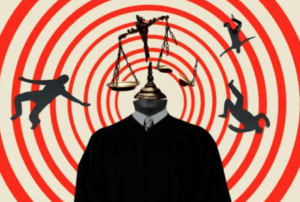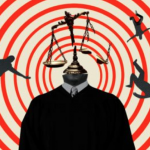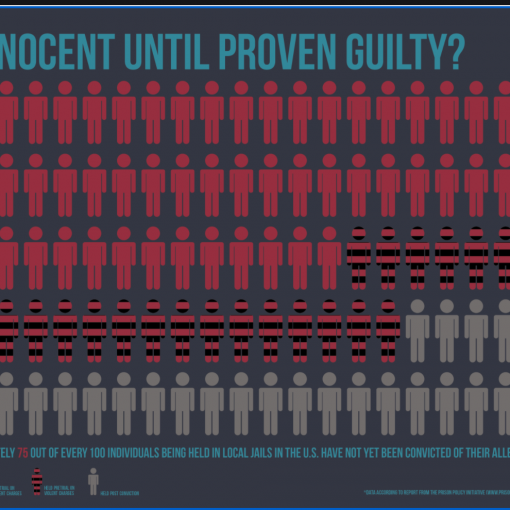 This post provides a disgruntling update to the judicial accountability bill mentioned in my previous post, titled House Bill 271 Could Tell Us Which Judges Make the Naughty List and Which Make the Nice List. [1] House Bill 271 unfortunately died early in the process, but it was originally intended to provide a starting point to judicial accountability by requiring Case Search to list the names of judges presiding over cases. [2] As emphasized previously, tracking the names of judges is necessary to discovering systemic patterns of bias in judicial decision-making. [3] For example, data analysis would reveal if judges decided cases in favor of certain races or genders more than others, or whether they tended to grant or deny protective orders. [4]
This post provides a disgruntling update to the judicial accountability bill mentioned in my previous post, titled House Bill 271 Could Tell Us Which Judges Make the Naughty List and Which Make the Nice List. [1] House Bill 271 unfortunately died early in the process, but it was originally intended to provide a starting point to judicial accountability by requiring Case Search to list the names of judges presiding over cases. [2] As emphasized previously, tracking the names of judges is necessary to discovering systemic patterns of bias in judicial decision-making. [3] For example, data analysis would reveal if judges decided cases in favor of certain races or genders more than others, or whether they tended to grant or deny protective orders. [4]
Simultaneous to Bill 271 was Governor Hogan’s proposed Judicial Transparency Act of 2022. [5] Under this Act, S.B. Bill 392 would have required data to be made available to the public on all sentences imposed on defendants convicted of committing violent crimes, including the names of the individual judges who handed out those sentences. [6] This bill was hailed for providing judicial accountability and transparency, while also allowing the public a chance to better understand the criminal justice system. [7] However, what started out as an important step into the larger criminal justice reform movement, morphed into something completely unrecognizable after encountering vehement opposition from the House and Senate Judicial Committees. [8]
The Senate was forced to acquiesce to the Judicial Proceedings Committee and adopt a series of amendments that thwarted any prospect of judicial accountability. [9] The amended version sought to collect sentencing data on violent crimes on a jurisdictional basis—most notably excluding from the data the names of the presiding judges and whether their sentences fell within the recommended sentencing guidelines. [10] Further, to ensure judges in smaller counties would not be more exposed than judges in larger counties, the Committee opted to aggregate the sentencing data from smaller counties by grouping them together as a single jurisdiction. [11] Though the amended version of the bill still passed the Senate with overwhelming bipartisan support, it unsurprisingly died in the House Judicial Committee. [12]
While neither version of Bill 392 succeeded into law, it must be emphasized that this bill was underwhelming to begin with, especially when compared to Bill 271’s inclusion of judges’ names for all types of cases on Case Search. [13] Those in support of Bill 392 thought it would cultivate transparency and provide useful data while preserving judicial independence. [14] One Senator in favor of the watered-down amended version, defended it as being fairer to judges because they shouldn’t be compared with each other based on their sentencing records since individual cases are like “apples to oranges” and no two are alike. [15] However, when you put that argument beside the necessity for judicial accountability and transparency to propel reform, you have two arguments that cannot coexist.
Those in favor of sustaining unparalleled protections for judges fail to realize that collecting data on judges and the subsequent information yielded from that data (over time) isn’t going to come down to an “apple and oranges” situation. Judges are less likely to be criticized or even revered from one single case; their public “judgment” will be the result of dozens, hundreds, or even thousands of cases that reveal patterns. [16] These patterns are necessary not just in terms of transparency to the public or for criminal justice reform, but to the judges themselves. [17] As expressed decades ago by legal philosopher, Jerome Frank, “hiding the flaws of courts and judges is not the road to minimizing or eliminating them.” [18] Having information necessary so judges can be aware of their own potential implicit biases will serve as the same type of “self-check” system that is rightfully imposed on the rest of us in modern times. [19]
This type of “self-check” system could help prevent the recurring systemic injustices that continue to undermine the already undervalued. [20] For instance, Alabamian Judge Les Hayes sent a single mom to jail for unpaid parking tickets for almost 500 days in 2012. [21] This resulted in her children being sent to foster care, where one child was molested, and another child was physically abused. [22] Four years later, an oversight committee found that Judge Hayes violated the judicial code of conduct, as well as state and federal laws in sending hundreds of other poor residents to jail for unpaid fines. [23] He was only sentenced to an 11-month unpaid suspension, or about 330 days, which is about 170 days less than the sentence he imposed on the single mother mentioned above. [24] Importantly, in an interview conducted with Reuters, Judge Hayes admitted that he didn’t realize he was doing anything wrong until he was disciplined. [25]
The example above is one of the reasons why judicial-specific data would universally be more informative and actionable than jurisdictional data alone. This is especially the case if, as the amended bill proposed, such data would be diluted by lumping multiple jurisdictions into a “single” jurisdiction because, while it may show a problematic pattern exist in a general area, it wouldn’t show the extent of that problem or where it originated from. This is why having data on our judges over all types of cases, in addition to data aggregated by jurisdiction has more power.

Power to put speculations to rest. [26]
Power to drive evidence-based reform. [27]
Power to hold judges accountable to “We, The People.”
And, for judges who don’t hold themselves accountable, power to the public and data analysts to expose discriminatory patterns of judicial decision-making. [28]
In summary, Bill 271 which would have required the names of judges to be assigned to cases on Case Search died in January 2022. The Judicial Accountability Act (which offered significantly less judicial accountability) and its amendments (which offered close to no judicial accountability) couldn’t survive beyond mid-March where the House Judicial Committee let it die despite it passing with bipartisan support in the Senate. [29] What ultimately did pass and will be enacted into law in October of 2022 is S.B. 763 which requires the Maryland State Commission on Criminal Sentencing Policy to provide an annual report on data involving violent crimes, organized by judicial circuit. [30] Note: this data will not include anything on the actual judiciary (aka the judges) but will instead aggregate data jurisdictionally. [31]
So, while the General Assembly guaranteed that all judges in Maryland will receive a whopping $40,000 in pay raises over the next four years, they failed to hold those very same judges accountable to those pay raises. [32] Come October of 2022, Marylanders will have just as much publicly-available judicial data that they had before – none.
Footnotes
[1] Jillianne Crescenzi, House Bill 271 Could Tell Us Which Judges Make the Naughty List and Which Make the Nice List, University of Baltimore L. Forum (Apr. 2022), https://blogs.ubalt.edu/legaldatadesign/house-bill-0271-could-tell-us-which-judges-make-the-naughty-list-and-which-make-the-nice-list/.
[2] H.B. 271, 2022 Leg., 444th Sess. (Md. 2022).
[3] Id. See also Agenda for Change, Initiative Seven: Judicial Accountability and Transparency, Court Watch Montgomery, https://courtwatchmontgomery.org/agenda-for-change/#init7 (last visited Apr. 18, 2022) (stating “Maryland courts collect a wide variety of data on civil and criminal domestic violence cases but much of it is not accessible to the public. This lack of transparency hampers public efforts to assess court performance or make data-driven policy decisions.”).
[4] Carolyn Hoffman and Sarah Stephens, What Does Strangulation in Montgomery County Look Like, Court Watch Montgomery, at 9 (June 2020), https://courtwatchmontgomery.org/wp-content
/uploads/2020/06/CWMStrangulationReport.pdf. A 2020 strangulation report conducted in Montgomery County, found that over half of respondents in protective order hearings alleging strangulation were also defendants in other criminal cases. For respondents who had multiple temporary protective orders against them, final protective orders were only granted 37% of the time in strangulation cases, compared to 48% of non-strangulation cases. See also Arizona Commission on Judicial Performance Review, Arizona Courts, https://www.azcourts.gov/jpr/Judicial-Performance-Reports/Judicial-Report/courtid/2 (last visited Apr. 19, 2022).
[5] S.B. 392, 2022 Leg., 444th Sess. (Md. 2022). Note: both Bill 271 and the 2022 Judicial Transparency Act were also proposed in the 2020 legislative session.
[6] Id. See also David Collins, Senate dramatically changes governor’s bill to hold judges accountable (last updated: Mar. 22, 2022), WBAL TV 11, https://www.wbaltv.com/article/maryland-senate-judicial-transparency-act-judge-accountability/39505363.
[7] Steve Lash, Md. Senate passes ‘watered down’ judicial transparency bill, The Daily Record (Mar. 21, 2022), https://thedailyrecord.com/2022/03/21/md-senate-passes-watered-down-judicial-transparency-bill/.
[8] Collins, supra note 6.
[9] Id.
[10] Id.
[11] Id. (“For example, Dorchester, Somerset, Wicomico and Worcester counties would be a listed as single entity, as would Caroline, Cecil, Kent, Queen Anne’s and Talbot counties. Allegany, Garrett and Washington counties would also be combined.”).
[12] See Governor Hogan Announces $45 Million For Major Violent Crime Initiatives, Expanded State Law Enforcement Initiatives and Coordination, Presses For Passage of Emergency Crime Bills, Presses for Passage of Emergency Crime Bills, Off. of Governor Larry Hogan, https://governor.maryland.gov/2022/03/24/governor-hogan-announces-45-million-for-major-violent-crime-initiatives-expanded-state-law-enforcement-initiatives-and-coordination-presses-for-passage-of-emergency-crime-bills/ (last visited Apr. 18, 2022) (stating “[t]he Judicial Transparency Act (SB 392), which unanimously passed the Senate earlier this month. The measure will require that, for the first time, detailed information is published on the sentences that are handed down for violent crimes.”).
[13] H.B. 0271, supra note 2.
[14] Lash, supra note 7.
[15] Id.
[16] See generally Arizona Commission on Judicial Performance Review, supra note 4 (showing judicial reports on Arizona judges based off of hundreds of surveys sent to litigants and attorneys evaluating judges). See also Michael Berens & John Shiffman, Objections Overruled Part 2: With ‘judges judging judges,’ rogues on the bench have little to fear, Reuters (July 2020), https://www.reuters.com/investigates/special-report/usa-judges-deals/.
[17] Bernice B. Donald, Jeffrey Rachlinski, & Andrew J. Wistrich, Getting Explicit About Implicit Bias, 3 Duke Judicature Bolch Judicial Institute 75, 78-79 (2020) (“Acknowledging the imperfections of the judiciary can be painful for judges — especially those subject to reselection — and can give rise to public criticism and even cynicism. Regrettably, most judges receive little systematic, meaningful feedback.”).
[18] Donald, Rachlinski, & Wistrich, supra note 17 (citing Jerome Frank, Courts on Trial: Myth and Reality in American Justice 429 (1949).
[19] Janna Adelstein & Alicia Bannon, State Courts’ Stark Lack of Diversity Demands Action, Brennan Center for Justice (July 6, 2021), https://www.brennancenter.org/our-work/analysis-opinion/state-courts-stark-lack-diversity-demands-action (“This stark lack of diversity doesn’t only reflect systemic inequities — it also contributes to them. Justices’ professional and life experiences shape the law in this country, and it’s vital that state courts reflect the diversity of the communities affected by their decisions. . . . https://www.brennancenter.org/our-work/analysis-opinion/state-courts-stark-lack-diversity-demands-action.”
[20] Michael Berens & John Shiffman, Objections Overruled Part 1: Thousands of U.S. judges who broke laws or oaths remained on the bench, Reuters (June 2020), https://www.reuters.com/investigates/special-report/usa-judges-misconduct/.
[21] Id.
[22] Id.
[23] Id.
[24] Id.
[25] Id.
[26] See e.g., Berens & Shiffman, supra note 20 (“In Pennsylvania, the state examined the convictions of more than 3,500 teenagers sentenced by two judges. The judges were convicted of taking kickbacks as part of a scheme to fill a private juvenile detention center. In 2009, the Pennsylvania Supreme Court appointed senior judge Arthur Grim to lead a victim review, and the state later expunged criminal records for 2,251 juveniles.”).
[27] Andrea Cipriano, Is There a Data Collection Problem in the Justice System, The Crime Report (Aug. 18, 2021), https://thecrimereport.org/2021/08/18/is-there-a-data-collection-problem-in-the-justice-system/ (“Without a solid foundation for evidence-based policymaking, it becomes impossible to track outcomes,” the authors argue in their report. “Reform is stifled. Racial discrepancies continue. Failed promises and opaque systems undermine public trust.”).
[28] See Donald, Rachlinski, & Wistrich, supra note 17 “. Computerized research services now compile statistics on judges’ rulings in various contexts. Judges can often examine such statistics. If readily available data is lacking, the clerk of the court, or the national or state administrative office, especially in this era of computerized dockets, can compile such data. . . . Judges have a responsibility to educate themselves about anything that might contribute to unfair or biased outcomes in their cases, and to take action to ensure that their decisions are unbiased and just.”
[29] Supra, note 12.
[30] The 90-Day Report, A Review of the 2022 Legislative Session, Dept. of Legislative Services, Maryland General Assembly, Part F, Courts and Civil Proceedings: Judicial Compensation (Apr. 2022), https://mgaleg.maryland.gov/Pubs/LegisLegal/2022rs-90-day-report.pdf.
[31] Id. at E8. This bill includes, among other things, the Department of Parole and Probation to provide the Senate and House Judicial Committees annual reports on data related to the oversight of offenders convicted of or involved in homicides and other data related to offenders. Additionally, this bill will also establish a Transparency Task Force for State’s Attorneys that will examine existing policies related to State’s Attorneys’ charging and sentencing history, as well as potentially explore developing transparency standards that will determine what information should be collected on criminals and made public.
[32] 90 Day Report, supra, note 20 (stating that the General Assembly failed to act on the recommendations submitted by the Judicial Compensation Commission within 50 days, and thereby the judicial raises were default enacted in accordance with statutory requirement).









